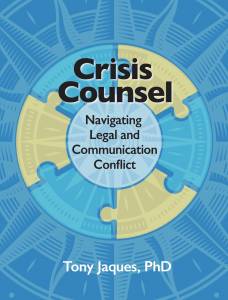COVID-19 is Challenging How We Use Data to Explain Risk Issues
by Tony Jaques PhD, Director of Issue Outcomes Pty Ltd, for people who work in issue and crisis management, author of Crisis Counsel: Navigating Legal and Communication Conflict.
COVID-19 and the worrying occurrence of some vaccine side-effects is proving yet again how hard it is to explain risk issues to the public and the media. Not to mention some politicians who seem unable to grasp (or willfully ignore) the basic principles of issue management and risk communication.
When an aged care resident died after receiving the vaccine it was not at all helpful to say that 1,000 people a week die in residential aged care of all causes. It’s equally unhelpful to compare the risk of vaccination with the likelihood of being struck by lightning.
Although the chance of a lightning strike is a much-loved benchmark, dragged out on just about every occasion – along with the likelihood of being attacked by a shark – it makes no sense to contrast a voluntary risk such as vaccination with an involuntary risk like being struck by lightning or a shark.
The more valid comparison in the present situation would be the risk of vaccination versus the risk of COVID infection. But the truth is data is hard to explain and even harder to comprehend.
Consider an Accenture global survey earlier this year of more than 9,000 employees in a variety of roles, which found only 21% were confident in their data literacy skills, meaning the ability to read, understand and manage data, and use it to communicate some message or story. And a recent survey of marketers across Australia found 46% said the biggest knowledge and skills gap in their teams is data and analytics.
Media understanding of data is likely not much better. Who can forget the notorious Daily Mail story a few years ago which breathlessly reported that property sales in the Sydney suburb of Mosman had grossed one trillion dollars in 12 months. What they meant, of course, was one billion dollars, or a thousand times less. (A trillion dollars would be well over half the entire GDP of Australia).
While it’s easy to laugh, the reality is many people would struggle to define the difference between a billion and a trillion, and big numbers are hard to understand, especially in a highly emotional and contentious context such as the COVID pandemic.
However, that’s no reason not to try. For example, when US COVID deaths passed half a million, the New York Times ran a front page graphic depicting exactly 500,000 little grey dots. While the newspaper’s “wall of grief” was innovative and created an interesting conversation piece, it’s hard to believe it really communicated any meaningful new understanding.
Rather than trying to visualise half a million fatalities, it is probably more effective to highlight the individual death of a celebrity people might recognise and identify with. Think no further than the publicity surrounding the COVID death of legendary broadcaster Larry King, or Broadway star Nick Cordero, aged just 41. Or the media frenzy when Donald Trump and Tom Hanks and Boris Johnson got infected.
So, what is the role of communicators and the media in explaining COVID vaccination and its risks? Jon Allsop wrote in the Columbia Journalism Review that pausing vaccine use following adverse outcomes “turned exceedingly rare incidents into a wall-to-wall news story” without actually changing the underlying available data. He pointed out that the pandemic lacks certainty and ready-made expert consensus within a media ecosystem that prizes those things.
At least part of the answer seems to lie in meaningful and relevant risk comparisons. Queensland researcher Dr Jenny Doust explained, for instance, that 500 out of a million women taking the contraceptive pill will develop a blood clot. Compare this with recent official government data that just four to six in a million people have developed a clot after receiving the AstraZeneca vaccine.
Sadly, the question is whether such data will change a person’s mind about taking COVID precautions or lining up for vaccination. As Jon Allsop concluded, communicating competing calculations and the increasingly complex variables that go into them is a very hard job indeed.
A Parting Thought
Social data is a goldmine. But if you don’t extract the gold it’s just a hill like any other.
– Ron Ploof
Learn more about Reputation Risk in Tony Jaques’ new book, Crisis Counsel: Navigating Legal and Communication Conflict.

